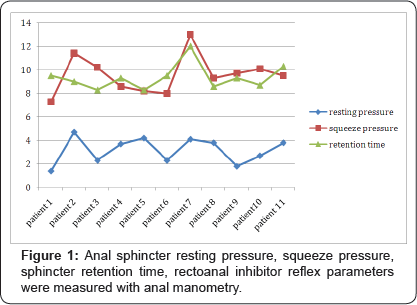Evaluation of Anal Tonus with Anorectal Manometry in Prolonged Anal Fissure Treatments
Ali Onur Erdem*, Sezen Ozkisacik and Mesut Yazici
Department of Pediatric Surgery, Adnan Menderes University, Turkey
Submission: August 15, 2017; Published: August 18, 2017
*Corresponding author: Ali Onur Erdem, Department of Pediatric Surgery, Adnan Menderes University, Turkey, Tel: 90 256 4441256; Fax: 90 256 2146495; Email: aoerdem@adu.edu.tr
How to cite this article: Ali O E, Sezen O, Mesut Y. Evaluation of Anal Tonus with Anorectal Manometry in Prolonged Anal Fissure Treatments. JOJ Nurse Health Care. 2017; 3(3): 555615. DOI: 10.19080/JOJNHC.2017.03.555615
Keywords
Keywords: Anorectal manometry; Anal fissure; Child; Constipation; Prolonged
Introduction
Anal sphincter spasm in anal fissures causes very serious problems in childhood. This is lead to increas constipation and new fissures formation in the anal canal. Reflex contractions occur in the anal canal due to pain in anal fissures This situation causes the constipation to become more severe.
Many methods have been tried to reduce sphincter spasm in anal fissure treatment. Chemical sphincterotomy is also a popular treatment approach nowadays. When the spasm in the sphincter is reduced, the blood flow to this area is increased and the healing process becomes easier.
Anal dilation is also a method which is reduced anal canal pressure. But, these cases should be well chosen because the child will not enjoyed with this method. For this reason, we thought that anorectal manometry is performed to measure anal canal pressure and performing a dilation program who has high- pressure in anal canal in these cases.
Material Methods
This research was planned after approval of Adnan Menderes University Ethics Committee. A total of 11 patients with advanced anal fissure due to chronic constipation who were referred to our outpatient clinic were included this research. An anorectal manometry was performed all of these patients before treatment and to measured anal tonus.
Anorectal manometry measurements were made using a 4-channel circular catheter. We were performed no anesthesia or sedation before and during the procedure. Anal sphincter resting pressure, squeeze pressure, sphincter retention time, rectoanal inhibitor reflex parameters were measured with anal manometry (Figure 1).

Results
Rectal biopsy was performed to exclude Hirschsprung desease in 2 patients with a negative rectoanal reflex. Although normal resting pressure values different from each other, no statistically significant increased who has prolonged anal fissure. With this finding, because of increased sphincter pressure who underwent anorectal manometry were not included in the dilation program.
Medical treatment was given to all the patients and healing was observed in all patients 6 month follow-up. All of the patients did not accept the anorectal manometry procedure planned for control after the treatment.
Conclusion
Anal fissure is a common anorectal disease especially in children who is under 3 years of age. These anal ulcers, which result from internal anal sphincter spasms and decreasedmucosal blood flow, heal later and maybe do not heal. They typically cause pain and bleeding during defecation [1].
The purpose of treatment is; to prevent fecal shedding and megarectum formation with reduced inflammation, pain, and sphincter spasm. For this, medical treatment can be planned with gaita softeners, softening creams and warm sitting bath. However, the recurrence rate is higher and the recovery rate is lower after medical treatment. In various studies has been shown that above 90% of medical recovery rates who has lower internal anal sphincter pressure [2]. In various studies it has been shown that the rate of recurrence is significantly reduced by lowering the sphincter pressure with anal dilation [3,4]. We though that the rate of recurrence may be reduced by anal dilatation before the medical treatment begins, especially who has high sphincteric pressure.
Posterior anal canal pressure which is an area of chronic fissures in adults, was found to be high in 85% of patients. The consistently high basal anal pressure is lead to impaired intrasphincteric blood flow and as a result the recovery is to be later [5-7]. In generally thought to that the anal pressure is get lower the blood flow and healing of the anal canal epithelium get better [5,8]. Dilatation, which is one of the oldest methods of lowering the sphincter pressure, is considered to be a method that can be used easily in children because it is easy to perform, does not require experience and is not given any chemicals in the body.
Very few studies have been done with anorectal manometry before chronic anal fissure and constipation treatment in children. With anorectal manometry, valuable data can be obtained in patients who is complained chronic constipation and prolonged anal fissure. Thus, in appropriate patients, the duration of treatment can be shortened and the need for more invasive procedures can be reduced.
References
- Gibbons CP, Read NW (1986) Anal hypertonia in fissures: cause or effect? Br J Surg 73(6): 443-445.
- Farid M, El NA, Youssef M, Omar W, Fouda E, et al. (2009) Idiopathic hypertensive anal canal: a place of internal sphincterotomy. J Gastrointest Surg 13(9): 1607-1613.
- Yakoot M, Abdel SM (2009) Study of efficacy and safety of a new local cream ('healer') in the treatment of chronic anal fissure: a prospective, randomized, single-blind, comparative study. Arq Gastroenterol 46(3): 179-182.
- Sajid MS, Rimple J, Cheek E, Baig MK (2008) The efficacy of diltiazem and glyceryltrinitrate for the medical management of chronic anal fissure: a meta-analysis. Int J Colorectal Dis 23(1): 1-6.
- Medhi B, Rao RS, Prakash A, Prakash O, Kaman L, et al. (2008) Recent advances in the pharmacotherapy of chronic anal fissure: an update. Asian J Surg 31(3): 154-163.
- Klosterhalfen B, Vogel P, Rixen H, Mittermayer C (1989) Topography of the inferior rectal artery: a possible cause of chronic, primary anal fissure. Dis Colon Rectum 32(1): 43-52.
- Gherardi GJ (1960) Pathology of the ganglionic-aganglionic junction in congenital megacolon. Arch Pathol 69: 520-523.
- Madalinski MH (2011) Identifying the best therapy for chronic anal fissure. World J Gastrointest Pharmacol Ther 2(2): 9-16.






























